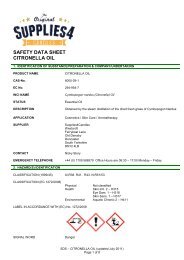Dawn-of-the-Dog
Dawn-of-the-Dog
Dawn-of-the-Dog
Create successful ePaper yourself
Turn your PDF publications into a flip-book with our unique Google optimized e-Paper software.
NEWS | FEATURESPHOTO: © THE UPPER GALILEE MUSEUM OF PREHISTORY<strong>the</strong> tooth back into its mandibleand slots <strong>the</strong> root intoa tiny Ziploc bag, where itwill be shipped to <strong>the</strong> UnitedKingdom for genetic analysis.“That’s about as good asit can go,” he exhales.The postdoc has made11 trips as one <strong>of</strong> <strong>the</strong> dogcollaboration’s two mainsample hunters, travelingfrom his home base at <strong>the</strong>University <strong>of</strong> Aberdeen too<strong>the</strong>r universities, museums,and even private collections.“I’m on a plane ortrain every 2 to 3 weeks,”he says. He’s probed wolfskulls in Serbia, cradleddog bones in Sweden, andscoured <strong>the</strong> archives <strong>of</strong> <strong>the</strong>Smithsonian Institution inWashington, D.C. Most <strong>of</strong><strong>the</strong> destinations come fromscanning <strong>the</strong> scientific literature,talking to experts,and putting up posters atpr<strong>of</strong>essional and amateurarchaeology conferences.“There’s a huge amountthat’s hidden in desk drawers,”he says.Hulme-Beaman is at OhioState because <strong>of</strong> a callLarson received from PaulSciulli, a retired physicalanthropologist who heardabout <strong>the</strong> collaboration. Hetold Larson he had accessto a bunch <strong>of</strong> ancient NativeAmerican dogs, some <strong>of</strong>which he had dug up himselfin unexpected places. “There are siteswhere you find nothing,” says Sciulli, whohas swung by to check on Hulme-Beaman’sprogress. “No houses, no signs <strong>of</strong> villagelife. Just graves. And it’s just people anddogs.” Most <strong>of</strong> <strong>the</strong> dogs were about <strong>the</strong> size<strong>of</strong> beagles, and some were buried with <strong>the</strong>irowners, one under a person’s arm. “Theseweren’t wild animals,” he says. “They werepart <strong>of</strong> <strong>the</strong> family.”Sciulli watches as Hulme-Beaman moveson to ano<strong>the</strong>r specimen, gingerly removinga yellow-brown cranium <strong>the</strong> size <strong>of</strong> a pineapplefrom a plastic bag. He places <strong>the</strong> sampleon a record-size disk, beneath a cameraattached to a jointed mechanical arm. Thenhe slowly rotates <strong>the</strong> disk, snapping a pictureevery 2 seconds as <strong>the</strong> images appearon a nearby laptop. “We’re tricking <strong>the</strong>computer into thinking that we’re walkingaround <strong>the</strong> object,” he explains. By <strong>the</strong> time<strong>the</strong> disk has done a 360, he has taken moreThe skeletons <strong>of</strong> a human and dog (upper left) discovered underneath a 12,000-year-oldhome in nor<strong>the</strong>rn Israel are early evidence <strong>of</strong> <strong>the</strong> human-canine bond.than 200 shots, and a three-dimensionalrendering <strong>of</strong> <strong>the</strong> skull pops up on <strong>the</strong> screen,rotating to expose every nook and cranny—a carbon copy cranium Hulme-Beaman canbring anywhere.The computer can now do somethingno archaeologist can: perform geometricmorphometric analysis <strong>of</strong> <strong>the</strong> skull. Thethousands <strong>of</strong> measurements it will takewill go far beyond mere length and widthto determine actual shapes: <strong>the</strong> precise circlets<strong>of</strong> eye sockets, <strong>the</strong> jut and jag <strong>of</strong> everytooth. Ancient DNA, Hulme-Beaman says,can tell you where an animal came from,but only such morphometric data can showyou domestication in progress—<strong>the</strong> sharperangling <strong>of</strong> <strong>the</strong> snout, for example, that tookplace as wolves morphed into dogs.“For <strong>the</strong> first time, we’re going to be ableto look at some <strong>of</strong> <strong>the</strong>se strange skulls like<strong>the</strong> Goyet skull and figure out how strange<strong>the</strong>y really are,” he says. “Are <strong>the</strong>y wolvesbecoming dogs, or are <strong>the</strong>yjust unusual wolves?” Combining<strong>the</strong> two approaches,he says, should allow <strong>the</strong>collaboration to home in onjust where dogs came from—and when this happened.“Archaeology is storytelling,”Hulme-Beaman says.“I think we’re going to beable to tell a great story.”AT THE END OF THE DAY,Hulme-Beaman packs up hislaptop and samples and preparesfor his next trip, likelyto Istanbul. Sciulli suggestsa detour, mentioning a museumin Cleveland that has“hundreds <strong>of</strong> bones” from alocal site; he says he can put<strong>the</strong> curator in touch. Hulme-Beaman looks tired, but hesmiles. “Sure,” he says, “giveme his number.”A continent away, Larsonand Dobney have continuedto make phone calls.Their collaboration hasnow swelled to 50 scientistsfrom around <strong>the</strong> world—experts on dogs, domestication,zooarchaeology, andgenetics. Larson estimatesthat <strong>the</strong> team has analyzedmore than 3000 wolf, dog,and mystery specimensso far, and he expects <strong>the</strong>group to submit its first paperthis summer. “I’ve beenreally encouraged by howeveryone has been gettingalong,” he says. “We have a lot more in commonthan we thought.”Larson feels confident that <strong>the</strong> work willsolve <strong>the</strong> mystery <strong>of</strong> dog domesticationonce and for all, though some experts aren’tso sure. Just throwing a lot <strong>of</strong> data at anenigma won’t necessarily unravel it, warnsRichard Meadow, <strong>the</strong> director <strong>of</strong> <strong>the</strong> zooarchaeologylaboratory at Harvard University’sPeabody Museum. “The more samplesyou get, <strong>the</strong> more complicated things get.”And Hulme-Beaman points out that even if<strong>the</strong>re is an answer, it’s likely to disgruntlesome <strong>of</strong> <strong>the</strong> collaborators.Still, <strong>the</strong> formerly warring camps seemsanguine. “I’m willing to accept a differentresult,” Savolainen says. “If I’m wrong, it willbe a bit embarrassing,” he laughs, “but scienceis about trying to find <strong>the</strong> truth.” Wayneagrees. “Even if what we find contradicts myhypo<strong>the</strong>sis, I’d be very happy,” he says. “I justwant an answer.” ■SCIENCE sciencemag.org17 APRIL 2015 • VOL 348 ISSUE 6232 279Published by AAAS



